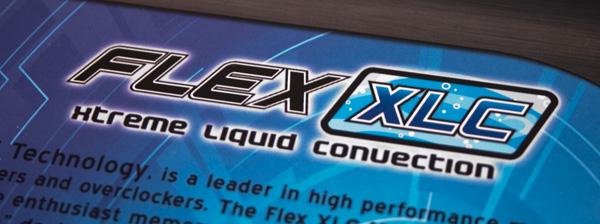OCZ Flex XLC Water-Cooled CAS-3 DDR2-800 2GB Memory Kit
Introduction

For reasons unknown, a good portion of the enthusiast market still thinks that memory cooling is a fruitless effort. Many high-end users still believe that memory chips run plenty cool, and that putting heat spreaders and heatsinks on them is a superficial effort at best, and that they don't provide any major benefits. The fact that nearly all high-end memory module and graphics card memory manufacturers use some sort of additional cooling doesn't seem to matter.
For a long time, I was a member of this camp as well. The first memory modules with heat-spreaders showed themselves in 2000-2001, right about the time that the industry was shifting from SDRAM to DDR SDRAM, and Rambus RDRAM modules were hitting the market, all of which needed to be equipped with heat-spreaders due to their implementations. It was right about the time when DDR-400 modules were hitting the market that DDR heat spreaders became all the rage. As clock speeds increased, heat spreaders became more and more prevalent, even though proof that they actually helped was questionable at best. Nowadays, they are more or less standard on high-end memory modules.
At first, memory chip heat spreaders were more for show and less for actual functionality, but once clock speeds of 800MHz+ hit, DDR and DDR2 modules start putting out some serious heat. Not only do modules have to dissipate self-created heat, but they also are (in most cases) sandwiched next to hot-running processors, chipsets, and graphics cards, all of which are outputting tremendous amounts of heat nearby. I've personally burned the ends of my fingers while touching un-cooled memory chips in cramped multi-core, multi-GPU systems running benchmarks. From that point on, we've come to realize that cooling one's memory modules may not be absolutely necessary all the time, but anytime you're dealing with that kind of heat, moving it away from the PCB and memory chips can only be a good thing, both for short term stability and long-term module reliability.
Now, with heat-spreaders and heatsinks both widely used, OCZ is taking the next step in terms of memory module cooling, a step which some might questions and others will be impressed by. Water cooling. Once it's mentioned, some enthusiasts will chuckle or raise an eyebrow at the thought. However, OCZ has gone about adding water-cooling to their memory modules in an intelligent fashion, by making it optional. This is the core design element of their new Flex XLC Edition memory modules.

Retail Packaging - Top |

Retail Packaging - Bottom |
|
|
|

This latest edition to the highly-awarded OCZ Flex XLC product family is engineered to produce significant performance gains on the latest Nvidia nForce SLI platforms by implementing Enhanced Performance Profiles (EPP) and allowing the memory to operate at a stable 800MHz at CL3 upon start up. The PC2-6400 CL 3 Flex modules are integrated with an EPP programmed SPD to immediately boot at the correct settings to produce 3-4-4 timings on nForce 680i motherboards. This feature provides a true "Plug and Play" overclocking feature that eliminates the need for manual configuration and makes memory optimizations a household item for the complete range of consumers looking to maximize system performance through overclocking.
|
|
Looking over the specifications, OCZ has concocted a very potent mix of features with the Flex XLC product lineup. While OCZ does produce similar modules using this same cooling system at ultra high clock speeds (up to 1150 MHz at the time of writing), these particular modules which we got our hands on are designed for efficiency at lower clock speeds rather than high clock speeds at higher latencies.
These modules run at low CAS 3-4-4 timings. The majority of enthusiast class DDR2-800 modules run at CAS 4-4-4, whereas mainstream modules run at CAS 5-5-5. Even better, these modules support EPP (or are "SLI-Ready", if you prefer), and will automatically clock themselves to CAS 3-4-4 timings if you have an EPP-ready motherboard.






